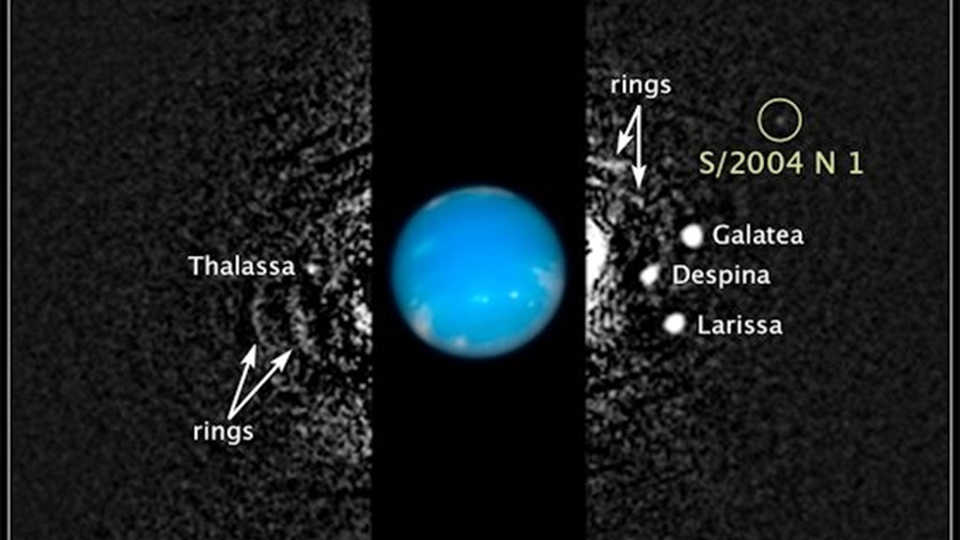We're open daily! View holiday hours
Science News
Neptune's New Moon
July 17, 2013
by Alyssa Keimach

Mark Showalter and his research team at the SETI Institute in Mountain View, California, are on a roll. They’ve shown us yet again how much we have to learn about our closest planetary neighbors.
In 2011 and 2012, Showalter’s team discovered two additional moons orbiting Pluto. (The International Astronomical Union recently decided on the names Kerberos and Styx for these moons, despite an overwhelming public vote to name one of them Vulcan.) Using the Hubble Space Telescope, the same researchers recently discovered a new moon orbiting Neptune.
“I got nice pictures of the arcs [segments of the planet’s rings], which was my main purpose, but I also got this little extra dot that I was not expecting to see,” says Showalter.
At 65,400 miles from Neptune, the speedy, newly-discovered moon completes an orbit every 23 hours. This moon is hard to track, but more than 150 archived images from Hubble between 2004 and 2009 enabled Showalter to track down the orbit of the new moon.
“The moons and arcs orbit very quickly, so we had to devise a way to follow their motion in order to bring out the details of the system,” he says. “It’s the same reason a sports photographer tracks a running athlete—the athlete stays in focus, but the background blurs.” (Showalter compares capturing the new moon to Eadweard James Muybridge’s famous racehorse photographs in a blog post earlier this week.)
This 12-mile wide moon is the smallest of the Neptunian system (which currently includes 14 moons), and revolves around Neptune between the orbits of Larissa and Proteus. For now the tiny dot is called S/2004 N 1. The official name may not be put to vote this time (but Star Trek fans can get cracking on ideas).
S/2004 N 1’s discovery brings up additional questions besides its new name. A mini moon like this should have had trouble forming in the neighborhood of much larger moons.
“How you can have a 20-kilometre object around Neptune is a little bit of a puzzle,” says Showalter. “It’s far enough away that its orbit is stable. Once you put it there it will stay there. The question is, how did it get there?”
Triton is Neptune’s biggest moon, orbiting in the direction opposite Neptune’s spin. Astronomers originally thought that a moon of this type would have to be captured by Neptune’s gravity, destroying all smaller moons in the process.
Stay tuned to learn S/2004 N 1’s new name, and perhaps new theories about how it originated in the first place!
Alyssa Keimach is an astronomy and astrophysics student at the University of Michigan and interns for the Morrison Planetarium.
Image: NASA, ESA, M. Showalter
In 2011 and 2012, Showalter’s team discovered two additional moons orbiting Pluto. (The International Astronomical Union recently decided on the names Kerberos and Styx for these moons, despite an overwhelming public vote to name one of them Vulcan.) Using the Hubble Space Telescope, the same researchers recently discovered a new moon orbiting Neptune.
“I got nice pictures of the arcs [segments of the planet’s rings], which was my main purpose, but I also got this little extra dot that I was not expecting to see,” says Showalter.
At 65,400 miles from Neptune, the speedy, newly-discovered moon completes an orbit every 23 hours. This moon is hard to track, but more than 150 archived images from Hubble between 2004 and 2009 enabled Showalter to track down the orbit of the new moon.
“The moons and arcs orbit very quickly, so we had to devise a way to follow their motion in order to bring out the details of the system,” he says. “It’s the same reason a sports photographer tracks a running athlete—the athlete stays in focus, but the background blurs.” (Showalter compares capturing the new moon to Eadweard James Muybridge’s famous racehorse photographs in a blog post earlier this week.)
This 12-mile wide moon is the smallest of the Neptunian system (which currently includes 14 moons), and revolves around Neptune between the orbits of Larissa and Proteus. For now the tiny dot is called S/2004 N 1. The official name may not be put to vote this time (but Star Trek fans can get cracking on ideas).
S/2004 N 1’s discovery brings up additional questions besides its new name. A mini moon like this should have had trouble forming in the neighborhood of much larger moons.
“How you can have a 20-kilometre object around Neptune is a little bit of a puzzle,” says Showalter. “It’s far enough away that its orbit is stable. Once you put it there it will stay there. The question is, how did it get there?”
Triton is Neptune’s biggest moon, orbiting in the direction opposite Neptune’s spin. Astronomers originally thought that a moon of this type would have to be captured by Neptune’s gravity, destroying all smaller moons in the process.
Stay tuned to learn S/2004 N 1’s new name, and perhaps new theories about how it originated in the first place!
Alyssa Keimach is an astronomy and astrophysics student at the University of Michigan and interns for the Morrison Planetarium.
Image: NASA, ESA, M. Showalter